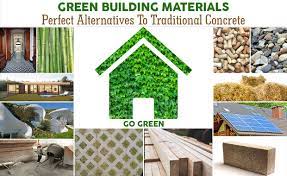Courtesy : dumpsters.com
Green building material for construction
Why Companies Choose Sustainable Building Materials
Whether you’re a contractor or a business owner, there are a number of reasons why you should consider green building materials for your construction project. Homeowners, contractors and businesses are switching to alternative building materials to limit environmental impact. Investing in sustainable construction creates an energy-efficient building, reduced carbon dioxide emissions all while boosting public perception as an environmentally responsible company.
What Is Green Building?
Also known as sustainable or high-performance building, green building is an environmentally responsible construction method. Green buildings are designed to reduce waste and use natural resources more efficiently.
What Are Some Examples of Green Building Materials?
1. Bamboo
Bamboo flooring is a popular alternative to traditional hardwood. Available in a variety of styles and colors, bamboo is a fast-growing grass that can provide a touch of sustainable personality to any space.
Pro Tip: When sourcing bamboo flooring, be sure to look for certification from the Forest Stewardship Council to ensure your wood is free from toxic chemicals.
2. Reclaimed Wood
Building with reclaimed wood is the most environmentally responsible way to reduce the amount of lumber in landfills and save trees. On top of that, the history of reclaimed wood adds plenty of character.
Where to Find Reclaimed Wood:
- Retired barns
- Salvage yards
- Specialty buyers
- Shipping crates and pallets
- Excavation companies
- Home remodeling companies and contractors
3. Cork
In recent years, cork flooring has become much more prevalent in homes and commercial spaces. One of the most sustainable building materials, the harvesting of cork does not harm the tree. And the bark from each tree can be stripped up to 20 times during its life cycle. Not only is it highly renewable, but cork also has hypoallergenic properties, fire retardant qualities and is resistant to liquids.
4. Mycelium
Mycelium are the rootlike fibers found on mushrooms. Mycologist Philip Ross originally experimented with fungi and mycelium for his art installations. Combined with pasteurized sawdust, Ross realized that mycelium could be formed into nearly any shape to be used as a surprisingly sturdy building material. The mushroom-based building material can withstand extreme temperatures, making it an organic and compostable alternative to home insulation, Styrofoam and even concrete.
5. Ferrock
Another concrete alternative, ferrock is created with steel dust, or ferrous rock, left over from industrial processes, usually sent to the landfill. When combined with carbon dioxide, an iron carbonate is formed. This viable alternative to cement can be mixed and poured to form driveways, pathways, staircases and more. And some researchers believe it may even be more resilient to weather than concrete.
6. Sheep’s Wool
In place of chemical-laden insulation, sheep’s wool is a great natural alternative. It insulates homes just as well as conventional insulation, but requires less energy to manufacture. One of the most eco-friendly ways to insulate your property, sheep’s wool can both increase energy efficiency and soundproof your office.
7. Recycled Steel
To save trees and provide increased durability for earthquakes and high winds, builders are using steel beams for the framing process in place of wood. According to the Steel Recycling Institute, a 2,000-square-foot house requires up to 50 trees to build, while a frame made from recycled steel requires the steel-equivalent of just six scrapped cars. Since steel is 100 percent recyclable, it can significantly reduce the ecological impact of new construction.
8. Low-E Windows
Windows can make a huge impact on the amount of energy you use to heat and cool your building. Short for low thermal emissivity, Low-E windows are often coated with tin dioxide. These thin layers help to absorb UV rays, blocking heat without limiting light. On top of cutting energy bills, Low-E windows can also help prevent fabrics and carpet from fading early.




